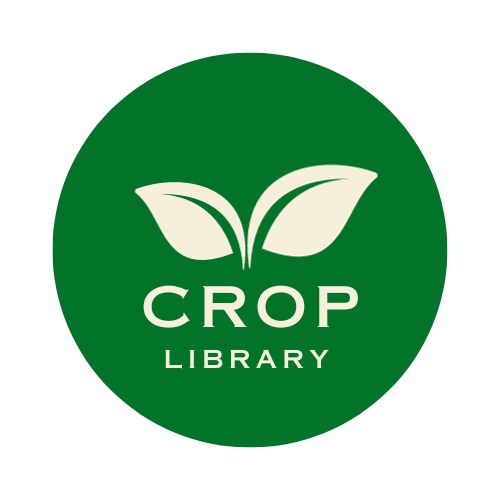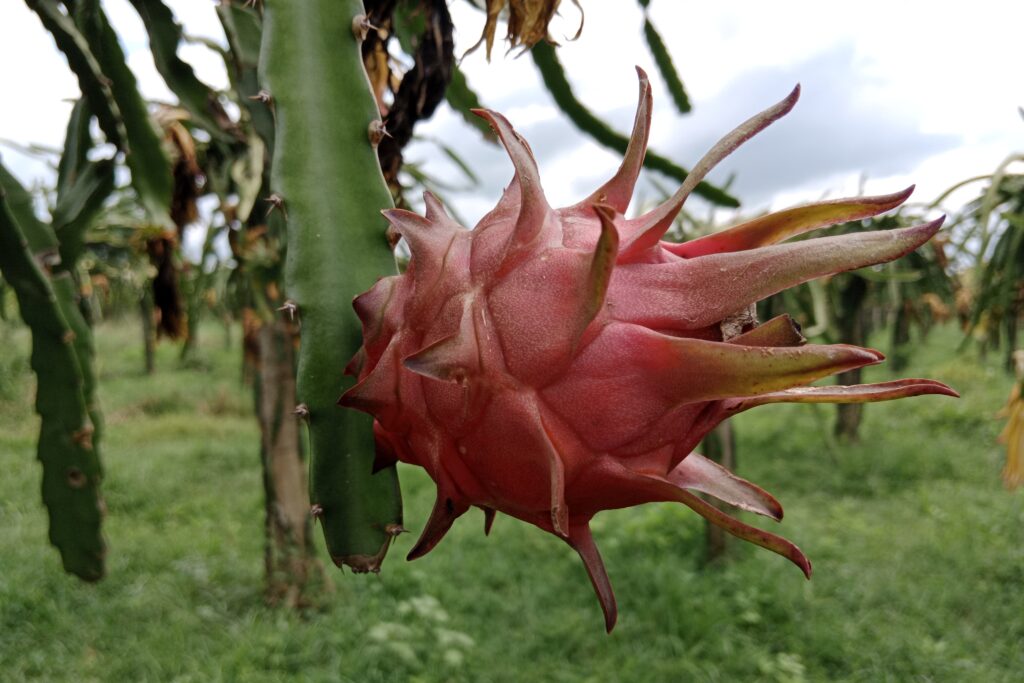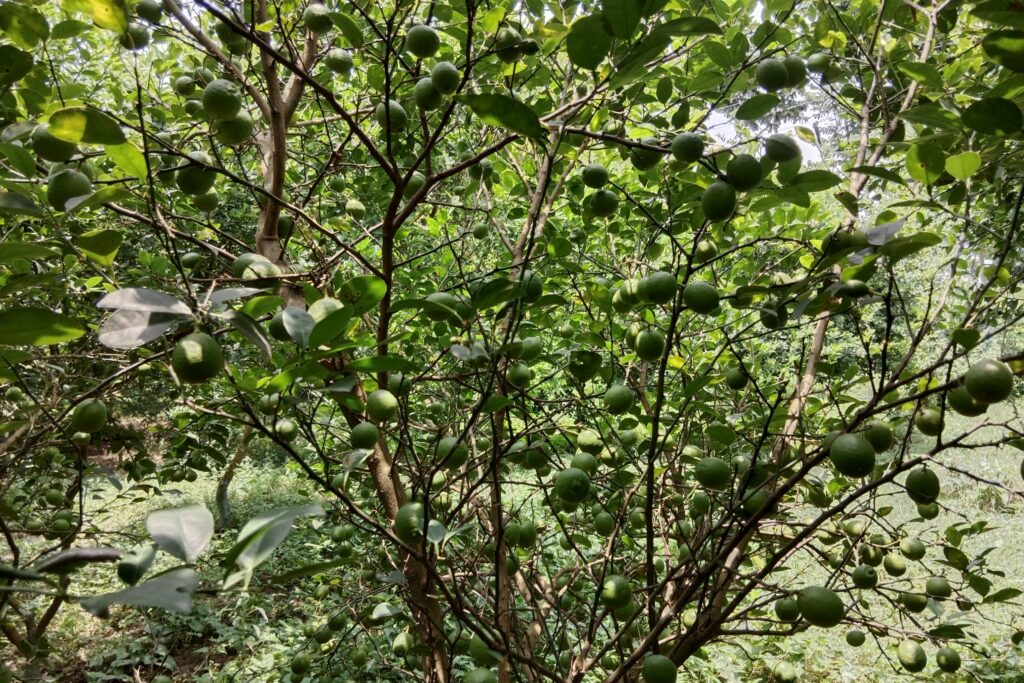Plum Cultivation
Successful plum cultivation requires mastering both growing techniques and post-harvest management to deliver premium-quality fruit. This comprehensive guide covers every critical phase, from orchard establishment to final market preparation. A key component of professional plum cultivation begins immediately after harvest, when fruits undergo rigorous grading by size, color and quality to meet exacting commercial standards.
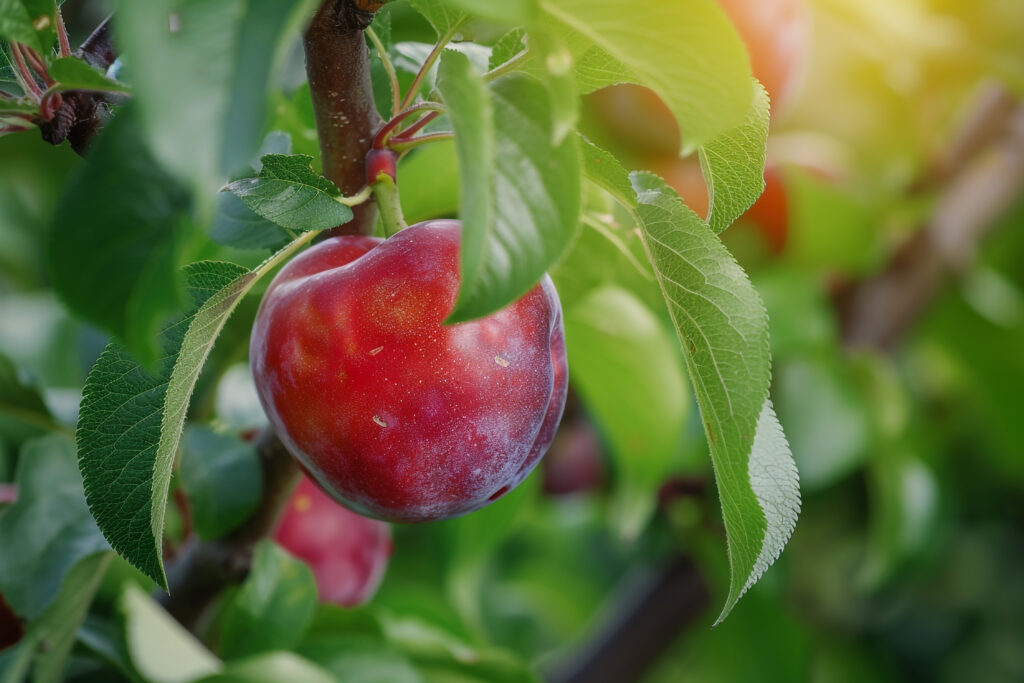
Proper storage protocols (0-1°C at 90-95% humidity) maintain freshness for 2-4 weeks, while advanced preservation methods like drying (prune production), canning and freezing allow year-round availability. Through this guide, you’ll discover how optimized post-harvest handling in plum cultivation minimizes losses while maximizing profitability – whether supplying fresh markets or value-added product lines. We’ll explore the complete journey of plum cultivation, equipping you with science-based practices for superior yields and fruit quality at every production stage.
Land Preparation
| Aspect | Details |
| Objective | Prepare land for plum cultivation by ensuring proper drainage and nutrient availability. |
| Soil Requirement | Well-drained, deep soils (avoid waterlogged or heavy clay soils). |
| Land Clearing | Remove weeds, rocks, and debris. |
| Tillage | 2–3 rounds of plowing and harrowing to achieve fine tilth. |
| Leveling | Ensure proper land leveling to prevent waterlogging. |
| Soil Testing | Conduct soil tests to identify nutrient deficiencies for optimal growth. |
Soil Type
Because they encourage healthy root development and optimal nutrient uptake, plums grow best in loamy, well-drained soils that are high in organic matter. Red lateritic soils that have good drainage are among the best varieties and increase yields. A slightly acidic to neutral pH range (5.8–6.5) is suitable for plum cultivation because maintaining appropriate pH levels improves nutrient availability and guards against shortages.
However, because of their inadequate aeration and excessive water retention, thick clay soils should be avoided as they raise the danger of fungal infections and root rot. In a similar vein, avoid damp soils as they suffocate roots and hinder tree growth. Establishing a fruitful and long-lasting plum orchard requires careful soil preparation and selection.
Climatic Requirements
| Climatic Factor | Requirement |
| Climate Type | Temperate |
| Optimal Temperature | 18–25°C (growth period) |
| Chilling Requirement | 500–1000 hours below 7°C (cultivar dependent) |
| Annual Rainfall | 700–1000 mm |
| Irrigation Needs | Supplemental irrigation required during dry spells |
| Altitude Range | 800–2000 meters (optimal for temperate varieties) |
| Minimum Altitude | Can succeed above 1200 meters if conditions are suitable |
Major Cultivars
| Category | Characteristics | Notable Cultivars | Uses |
| European Plum (Prunus domestica) | Sweet, firm flesh; versatile for fresh eating, drying (prunes), and processing | · Stanley: Deep purple skin, yellow flesh, high yielding · President: Large, dark purple, long shelf life · Bluefre: Uniform size, deep blue skin, juicy · Victoria: Yellow-red skin, sweet, tender | Fresh consumption, drying, canning, desserts, preserves |
| Japanese Plum (Prunus salicina) | Larger size, juicier texture, earlier ripening, tart-sweet flavor | · Santa Rosa: Red-purple skin, amber flesh, adaptable · Black Amber: Nearly black skin, firm sweet flesh · Friar: Light purple, honey-sweet, excellent storage · Red Beaut: Vibrant red, crisp, mildly acidic | Fresh markets, warm climate cultivation, commercial use |
| Hybrid Varieties | Crosses between species with unique flavors and textures | · Pluot (plum-apricot): Flavor King, Dapple Dandy (very sweet) · Mariposa: Deep red, sugary, freestone | Fresh consumption, specialty markets |
Planting Details of Plum
| Planting Aspect | Details |
| Planting Season | · Temperate regions: Late winter to early spring (dormant season) · Subtropical regions: After monsoon season (to avoid waterlogging)
|
| Spacing | · Standard trees: 5m × 5m (low-density, ~160 trees/acre) · Dwarf varieties: 3m × 3m (high-density, ~450 trees/acre)
|
| Pit Preparation | · Size: 60cm × 60cm × 60cm (prepared 2-3 weeks in advance) · Enrichment per pit:
|
| Planting Method | · Position sapling with graft union 2-3″ above soil · Backfill with enriched soil mixture · Firm soil gently to remove air pockets · Water thoroughly · Stake trees in wind-prone areas
|
| Plant Density | · Standard: ~160 trees/acre (5m×5m) · High-density: ~450 trees/acre (3m×3m) · Requires more intensive management (pruning, trellising) |
Intercropping
Intercropping in young plum orchards is an effective way to maximize land use and generate additional income during the initial years. Ideal intercrops include nitrogen-fixing legumes like beans and peas, as well as low-competition crops such as garlic, onions, and strawberries, which thrive in partial shade. Avoid tall crops like maize or sugarcane, as they compete aggressively for sunlight, water, and nutrients, hindering plum tree growth.
Intercropping should be phased out after 3–4 years, once the plum trees’ canopy fully develops and shades the ground. At this stage, competition for resources can reduce yields for both the intercrops and the plum trees. Transitioning to sole plum cultivation ensures optimal growth and fruit production.
When managed properly, intercropping enhances early-stage profitability and improves soil health through crop diversity. This practice supports young orchards by maintaining soil fertility and reducing weed pressure, setting the foundation for a thriving plum plantation in later years.
Irrigation for Plum Cultivation
For young plum plants, frequent but light irrigation (every 7–10 days) is essential to support healthy root establishment. As trees mature, their water needs change—mature plum trees require deep, thorough watering every 2–3 weeks, with drip irrigation being the most efficient method for precise water delivery.
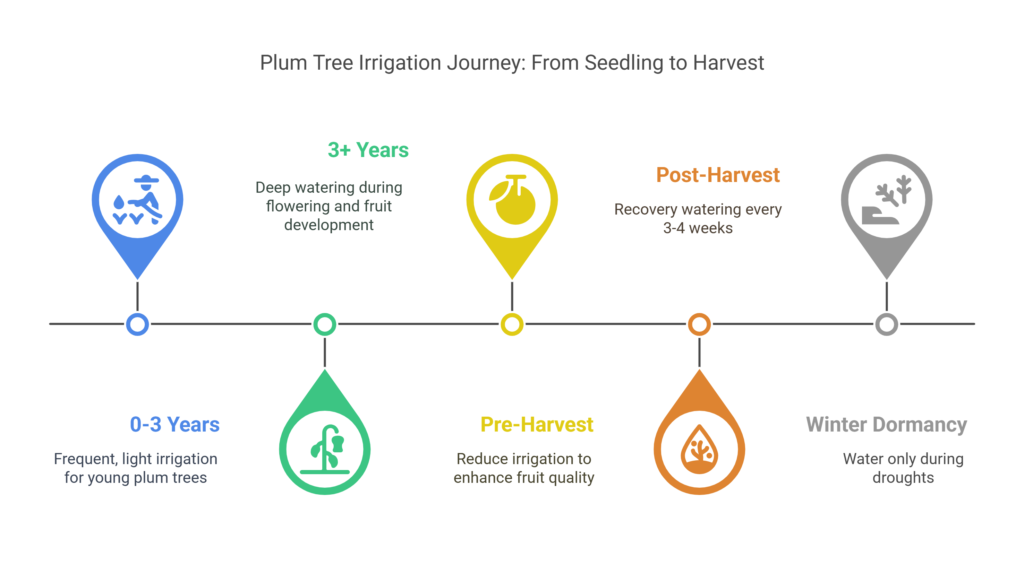
During critical growth stages like flowering and fruit set, maintaining consistent soil moisture is vital to prevent flower and fruit drop. Adequate irrigation throughout fruit development ensures optimal growth and size. However, as harvest approaches, reducing water supply helps enhance fruit quality by minimizing cracking and boosting sugar concentration.
a). Young Plum Trees (0-3 Years)
Newly planted plum trees require frequent, light irrigation every 5-7 days to maintain consistent soil moisture without waterlogging. As trees mature (1-3 years), adjust to deep watering every 10-14 days in summer, reducing frequency during monsoons. This encourages strong root development while preventing stress during establishment.
b). Productive Stage (3+ Years – Flowering to Fruit Development)
During pre-flowering, maintain weekly summer irrigation (40-60L/tree) to prepare trees for bloom. Critical flowering/fruit-set phases demand 7–10-day intervals (50-70L) to prevent flower drop. Through fruit development, water every 10-14 days (60-80L) to support sizing while avoiding fluctuations that cause cracking.
c). Harvest & Dormancy Phase
Reduce irrigation to 15–20-day intervals (30-50L) pre-harvest to enhance sugar content. Post-harvest, provide 40-60L every 3-4 weeks for recovery. In winter dormancy, water only during droughts (20-30L), as excess moisture harms dormant roots. Drip irrigation proves most efficient throughout all growth stages.
Fertilizers and Manure for Plum Cultivation
a). Initial Fertilization at Planting
For healthy establishment, each planting pit should receive a basal dose containing 10-15 kg of well-decomposed farmyard manure (FYM), 500g of single super phosphate (SSP), 50g of neem cake (which acts as both a pest deterrent and soil conditioner), 50g of Trichoderma viride (for disease control), and 50g of biofertilizers (including nitrogen-fixing bacteria, phosphate-solubilizing bacteria (PSB), and potash-mobilizing bacteria), creating a nutrient-rich foundation that promotes vigorous root development and enhances soil biology to support young plum trees during their critical early growth stages.
b). Annual Fertilization Schedule
Plum trees require progressively adjusted fertilization throughout their growth stages, beginning with 10-15kg of farmyard manure (FYM), 200-300g of urea, 500g of single super phosphate (SSP), and 150g of muriate of potash (MOP) during years 1-2, increasing to 20-25kg FYM, 400-500g urea, 750g SSP, and 300g MOP in years 3-5, and reaching 30-40kg FYM, 600-800g urea, 1000g SSP, and 500g MOP for mature trees (5+ years), with organic manure applied in winter and chemical fertilizers administered in split doses while maintaining an optimal 2:1 NPK ratio for balanced nutrition and healthy tree development.
c). Application Method
For optimal plum tree nutrition, adopt a two-phase split application method: during pre-flowering, apply 50% of the nitrogen requirement along with 100% phosphorus and 50% potassium to enhance flowering, followed by the remaining 50% nitrogen and 50% potassium after fruit set to support fruit development, ensuring nutrients are precisely timed to meet the tree’s needs – phosphorus for robust bloom initiation and nitrogen/potassium for proper fruit growth and quality enhancement.
Weed Control
| Weed Control Method | Implementation | Key Considerations |
| Mulching | Apply organic mulch (straw/dry leaves) around trees | Suppresses weeds while retaining soil moisture |
| Mechanical Weeding | Regular shallow hoeing | Avoid deep tillage to prevent root damage |
| Herbicide Use | Targeted application of post-emergence herbicides (e.g., Glyphosate) | Prevent contact with tree trunk/foliage; use only for persistent weeds |
| General Approach | Combine all three methods for effective weed management | Balance effectiveness with tree safety |
Pest and Disease Management
Major Pests
| Pest | Description | Damage Symptoms | Management Strategies |
| Crown Borer (Clearwing Moth Larvae) | Moderate pest affecting plum, apricot, nectarine, and peach trees. Adults emerge in late June to lay eggs near trunks/roots. Larvae tunnel under bark at soil level. | ü Girdling of trees ü Oozing sap mixed with frass ü Canopy dieback ü Loose bark ü Pupal cases visible | – Keep trunk base weed-free – Monthly preventive sprays (permethrin/carbaryl) July–Sept (lower 12–18″ of trunk) – Organic options: spinosad (every 10 days) or beneficial nematodes |
| Peach Tree Borer (Synanthedon exitiosa) & Lesser Peach Tree Borer (Synanthedon pictipes) | Larvae feed on inner bark; adults are steel-blue, yellow-orange-marked clearwing moths (wasp-like). | ü Bark girdling ü Bark peeling ü Gumming ü Tree death in severe cases | – Monitor for adult activity – Insecticide sprays targeting larvae – Remove heavily infested bark |
| Plum Curculio | Beetle that damages fruit via feeding, egg-laying (larvae tunnel inside fruit), and spreads brown rot. Females make crescent-shaped cuts under eggs. | ü Premature fruit drop ü Crescent-shaped scars on fruit ü Internal fruit tunneling by larvae | – Timely insecticide sprays during egg-laying – Remove fallen fruit to reduce larvae – Use traps for monitoring |
Major Diseases
| Disease | Causal Agent | Affected Plants | Symptoms | Management/Prevention |
| a). Crown Rot and Root Rot | Soil-borne Phytophthora | Fruit trees worldwide | Stunted growth, yellowing leaves, undersized fruit, wilting, dieback, abrupt death; brown discoloration under bark | Plant in well-drained soil, avoid replanting in infected areas, use phosphorous acid to prevent spread |
| b). Perennial Canker | Fungus (Cytospora canker) | Plums, apricot, cherry, nectarine, peach | Oval sunken cankers, dark amber gum, dead branches, loose bark; brown discoloration under scraped bark | Prevent bark injuries (winter wraps), control wood-boring insects, prune 4 inches below canker into healthy wood |
| c). Plum Pox Virus (PPV) | Virus (PPV) | Stone fruits (plums, peaches, etc.) | Chlorotic rings, deformed fruit, reduced yield (symptoms vary by strain) | No cure—remove and destroy infected trees; plant certified virus-free saplings |
Harvesting
| Category | Details |
| Fruit-Bearing Age | 3–5 years after planting |
| Peak Yield Age | 6–7 years |
| Harvest Seasons | · Early varieties: May–June · Mid-season: June–July · Late varieties: August–September |
| Ripeness Indicators | · Slight softening · Color change (varies by cultivar) · Easy stem separation |
| Yield per Tree | · Young trees (3–5 yrs): 15–25 kg · Mature trees (6+ yrs): 50–100 kg |
Post-Harvest Handling
Plums are graded after harvesting to guarantee uniformity in size, color, and quality, satisfying market and customer demands. To preserve firmness and avoid moisture loss, they should be stored for a brief period of time (two to four weeks) in cool, humid settings (0 to 1°C with 90 to 95% humidity). The nutritional content of plums can be preserved and their shelf life increased by processing them into canned goods, dried prunes, or frozen items if extended preservation is required. From sorting to storage, proper handling minimizes deterioration and guarantees that the fruit is still viable.
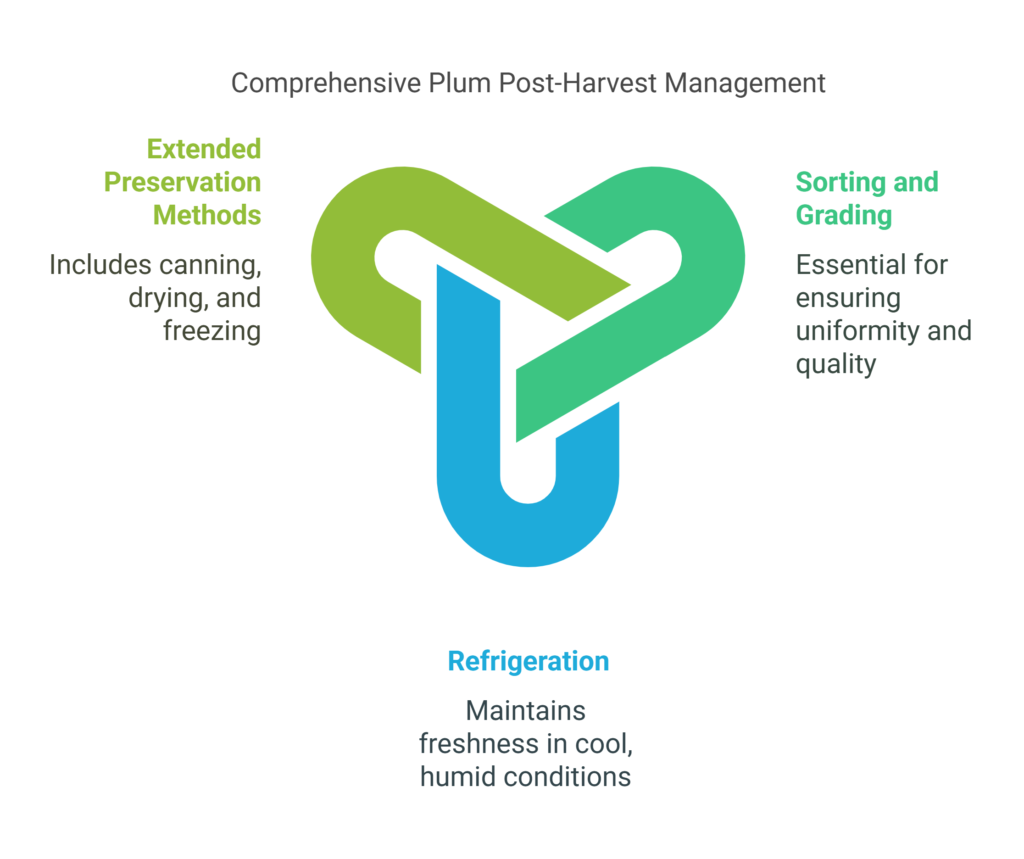
To maintain plum quality post-harvest, sorting and grading are essential steps, where fruits are categorized based on size, appearance, and ripeness. Refrigeration (0–1°C) with high humidity (90–95%) is ideal for short-term storage, keeping plums fresh for up to a month. For extended preservation, methods like canning, drying (producing prunes), and freezing are effective, locking in flavor and nutrients. By following these post-harvest protocols, producers can minimize waste, enhance shelf life, and deliver high-quality plums to consumers.
